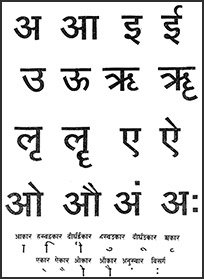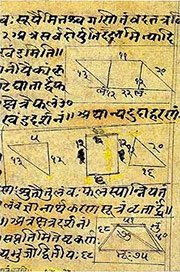Bhavita, Bhāvita, Bhāvitā: 21 definitions
Introduction:
Bhavita means something in Hinduism, Sanskrit, Buddhism, Pali, Marathi, Hindi. If you want to know the exact meaning, history, etymology or English translation of this term then check out the descriptions on this page. Add your comment or reference to a book if you want to contribute to this summary article.
Alternative spellings of this word include Bhavit.
Images (photo gallery)
(+19 more images available)
In Hinduism
Natyashastra (theatrics and dramaturgy)
Source: Wisdom Library: Nāṭya-śāstra1) Bhāvita (भावित) is another name (synonym) of bhāva, referring to “psychological states” (eg. permanent, involuntary, transitory), according to the Nāṭyaśāstra chapter 7.
2) Bhāvita (भावित) refers to one of the twelve types of lāsya, or “gentle form of dance” according to the Nāṭyaśāstra chapter 20. It is also known by the name Bhāva. These various lāsya are presented as a specific type of dramatic play (nāṭya) similar to that of the Bhāṇa type.
Source: archive.org: Natya ShastraBhāvita (भावित).—One of the twelve types of lāsya;—If a woman who is burning with the fire of love after seeing her beloved in a dream, expresses her different Psychological States, it is an instance of the Bhāvita.

Natyashastra (नाट्यशास्त्र, nāṭyaśāstra) refers to both the ancient Indian tradition (shastra) of performing arts, (natya—theatrics, drama, dance, music), as well as the name of a Sanskrit work dealing with these subjects. It also teaches the rules for composing Dramatic plays (nataka), construction and performance of Theater, and Poetic works (kavya).
Vyakarana (Sanskrit grammar)
Source: Wikisource: A dictionary of Sanskrit grammarBhāvita (भावित).—Designated by a technical term; cf. किं पुनरिदं तद्भावितग्रहणं वृद्धिरित्येवं ये आकारैकारौकारा विहिता भाव्यन्ते तेषां ग्रहणं आहोस्विद् आदैन्मात्रस्य (kiṃ punaridaṃ tadbhāvitagrahaṇaṃ vṛddhirityevaṃ ye ākāraikāraukārā vihitā bhāvyante teṣāṃ grahaṇaṃ āhosvid ādainmātrasya), M.Bh.on P.I.11.

Vyakarana (व्याकरण, vyākaraṇa) refers to Sanskrit grammar and represents one of the six additional sciences (vedanga) to be studied along with the Vedas. Vyakarana concerns itself with the rules of Sanskrit grammar and linguistic analysis in order to establish the correct context of words and sentences.
Shaktism (Shakta philosophy)
Source: Google Books: ManthanabhairavatantramBhāvita (भावित) refers to “infusion”, according to the Ciñcinīmatasārasamuccaya verse 4.27-29.—Accordingly, “The essential nature of the individual soul (aṇu) is the Self that has been supremely infused [i.e., para-bhāvita] with the power of consciousness. It is present in the branches of the Kula (i.e. the body) in association with the various supports (ādhārabheda). O goddess, one place and another bring each other to rest. Contemplated by (direct) experience, (each is of) a separate kind (and each bestows) a separate accomplishment. O goddess, I have explained that which is known as Āṇava”.

Shakta (शाक्त, śākta) or Shaktism (śāktism) represents a tradition of Hinduism where the Goddess (Devi) is revered and worshipped. Shakta literature includes a range of scriptures, including various Agamas and Tantras, although its roots may be traced back to the Vedas.
Ganitashastra (Mathematics and Algebra)
Source: archive.org: Hindu Mathematics1) Bhāvita (भावित) refers to the “product” or “multiplication” (of two or more unknown quantities), according to the principles of Bījagaṇita (“algebra” or ‘science of calculation’), according to Gaṇita-śāstra, ancient Indian mathematics and astronomy.—The symbols for powers and roots are abbreviations of Sanskrit words of those imports and are placed after the number affected. [...] The product of two or more unknown quantities is indicated by writing bhā (from bhāvita, product) after the unknowns with or without interposed dots ; e.g., yāva-kāgha-bhā [or yāvakāghabhā] means (yā) (kā).
Brahmagupta (628) in the Brāhmasphuṭasiddhānta: “The product of two like unknowns is a square; the product of three or more like unknowns is a power of that designation. The multiplication of unknowns of unlike species is the same as the mutual product of symbols; it is called bhāvita (product or factum)”.
Bhāskara II in the Bījagaṇita: “A known quantity multiplied by an unknown becomes unknown; the product of two, three or more unknowns of like species is its square, cube, etc.; and the product of those of unlike species is their bhāvita. [...]”.
2) Bhāvita (भावित) refers to “equations involving products of unknowns” and represents one of the classes of Samīkaraṇa (“equations”), according to the principles of Bījagaṇita.—Brahmagupta (628) in the Brāhmasphuṭasiddhānta has classified equations as three classes [e.g., equations involving products of unknowns (bhāvita)] [...]. Pṛthūdakasvāmī (860) in his commentary on the Brāhmasphuṭasiddhānta by Brahmagupta adopts four classes.

Ganitashastra (शिल्पशास्त्र, gaṇitaśāstra) refers to the ancient Indian science of mathematics, algebra, number theory, arithmetic, etc. Closely allied with astronomy, both were commonly taught and studied in universities, even since the 1st millennium BCE. Ganita-shastra also includes ritualistic math-books such as the Shulba-sutras.
Yoga (school of philosophy)
Source: ORA: Amanaska (king of all yogas): A Critical Edition and Annotated Translation by Jason BirchBhāvita (भावित) refers to “having manifested (one’s supreme bliss)”, according to Hemacandra’s Yogaśāstra (verse 12.33-35).—Accordingly, [while describing a method for conquering the mind]: “[He whose] self is constantly immersed in detachment; [who is] free from effort and whose supreme bliss has manifested (bhāvita-paramānanda), does not fix his mind on any place. A mind that is disregarded by the self, never governs the sense organs and so, even the sense organs do not act with respect to their own respective objects. When the self does not impel the mind and the mind does not impel the sense organs, then [the mind] which falls away from both, naturally attains dissolution”.

Yoga is originally considered a branch of Hindu philosophy (astika), but both ancient and modern Yoga combine the physical, mental and spiritual. Yoga teaches various physical techniques also known as āsanas (postures), used for various purposes (eg., meditation, contemplation, relaxation).
Ayurveda (science of life)
Agriculture (Krishi) and Vrikshayurveda (study of Plant life)
Source: Shodhganga: Drumavichitrikarnam—Plant mutagenesis in ancient IndiaBhāvita (भावित) refers to “culturing a seed”, as prescribed by certain bio-organical recipes for plant mutagenesis, according to the Vṛkṣāyurveda by Sūrapāla (1000 CE): an encyclopedic work dealing with the study of trees and the principles of ancient Indian agriculture.—Accordingly, “The seed of Cordia dichotoma should be forced out and cultured seven times (sapta-bhāvita) in the flesh (oil) of Alangium salviifolium and then it should be rubbed with the dung of she- buffalo and dried in shade. If these seeds are mixed in dry buffalo dung and earth and sown and watered with coconut water (gale water?) they turn into a plant of Nymphaea alba or Nymphaea nouchali and there is no wonder”.

Āyurveda (आयुर्वेद, ayurveda) is a branch of Indian science dealing with medicine, herbalism, taxology, anatomy, surgery, alchemy and related topics. Traditional practice of Āyurveda in ancient India dates back to at least the first millenium BC. Literature is commonly written in Sanskrit using various poetic metres.
Languages of India and abroad
Pali-English dictionary
Source: BuddhaSasana: Concise Pali-English Dictionarybhāvita : (pp. of bhāveti) increased; cultivated; developed.
Source: Sutta: The Pali Text Society's Pali-English DictionaryBhāvita, (pp. of bhāveti) developed, made to become by means of thought, cultured, well-balanced A. V, 299 (cittaṃ parittaṃ abhāvitaṃ; opp. cittaṃ appamāṇaṃ subhāvitaṃ); Sn. 516, 558. (Page 503)

Pali is the language of the Tipiṭaka, which is the sacred canon of Theravāda Buddhism and contains much of the Buddha’s speech. Closeley related to Sanskrit, both languages are used interchangeably between religions.
Marathi-English dictionary
Source: DDSA: The Molesworth Marathi and English Dictionarybhavitā (भविता).—a S (tā-trī-tṛ m f n) That is to be, future.
--- OR ---
bhāvita (भावित).—n S The product of two or more unknown quantities: also an equation containing such product.
--- OR ---
bhāvita (भावित).—p S Conceived, imagined, thought. 2 That has undergone any of the operations called bhāvanā q. v. Sig. IV.
Source: DDSA: The Aryabhusan school dictionary, Marathi-Englishbhāvita (भावित).—n Product of two or more un- known quantities. a Conceived, imagined.
Marathi is an Indo-European language having over 70 million native speakers people in (predominantly) Maharashtra India. Marathi, like many other Indo-Aryan languages, evolved from early forms of Prakrit, which itself is a subset of Sanskrit, one of the most ancient languages of the world.
Sanskrit dictionary
Source: DDSA: The practical Sanskrit-English dictionaryBhāvita (भावित).—p. p. [bhū-ṇic karmaṇi-kta]
1) Created, produced; obtained, got.
2) Manifested, displayed, exhibited; भावितविषवेगविक्रियः (bhāvitaviṣavegavikriyaḥ) Dk.; (bhaje) भक्तेष्वलं भावितभूतभावनम् (bhakteṣvalaṃ bhāvitabhūtabhāvanam) Bhāg. 5.17.18.
3) Cherished, fostered; तेषां दृष्ट्वा भावितानीङ्गितानि प्रोवाच राजा जनमेजयोऽथ (teṣāṃ dṛṣṭvā bhāvitānīṅgitāni provāca rājā janamejayo'tha) Mahābhārata (Bombay) 1.55.17.
4) (a) Conceived, imagined, supposed, presented to the imagination; तं तमेवैति कौन्तेय सदा तद्भावभावितः (taṃ tamevaiti kaunteya sadā tadbhāvabhāvitaḥ) Bhagavadgītā (Bombay) 8.6. (b) Known, recognized, acknowledged.
5) Thought of, meditated upon.
6) Made to become, transformed into.
7) Sanctified by meditation; अनन्यभावे निजधर्मभाविते मनस्यवस्थाप्य भजस्व पूरुषम् (ananyabhāve nijadharmabhāvite manasyavasthāpya bhajasva pūruṣam) Bhāgavata 4.8.22; see भावितात्मन् (bhāvitātman).
8) Proved, established.
9) Pervaded by, filled or saturated with, inspired by.
1) Soaked, steeped, infused in; किञ्चित् स्निग्धं यथा च स्याच्छुष्कचूर्णमभावितम् (kiñcit snigdhaṃ yathā ca syācchuṣkacūrṇamabhāvitam) Mahābhārata (Bombay) 12.195.18.
11) Perfumed, scented.
12) Mixed with.
13) (In math.). Involving the products of unknown quantities.
14) Directed towards, fixed upon; यदीश्वरे भगवति कर्म ब्रह्मणि भावितम् (yadīśvare bhagavati karma brahmaṇi bhāvitam) Bhāgavata 1.5.32.
15) Possessed, captured (vaśīkṛta); ततोऽन्ये यथाकामं दुदुहुः पृथुभाविताम् (tato'nye yathākāmaṃ duduhuḥ pṛthubhāvitām) Bhāgavata 4.18.13.
16) Engrossed, filled; रथाङ्गपाणेरनुभावभावितम् (rathāṅgapāṇeranubhāvabhāvitam) Bhāgavata 12.1. 42.
17) Pleased, gladdened; इष्टान् भोगान् हि वो देवा दास्यन्ते यज्ञभाविताः (iṣṭān bhogān hi vo devā dāsyante yajñabhāvitāḥ) Bhagavadgītā (Bombay) 3.12.
-tam Product obtained by multiplication, a factum.
--- OR ---
Bhāvitā (भाविता).—
1) The state of being or becoming.
2) Futurity.
3) Predestination.
Source: Cologne Digital Sanskrit Dictionaries: Shabda-Sagara Sanskrit-English DictionaryBhavita (भवित).—mfn.
(-taḥ-tā-taṃ) Been, become. E. bhava being, itac aff.
--- OR ---
Bhāvita (भावित).—mfn.
(-taḥ-tā-taṃ) 1. Occupied with, pervaded by, having as an inherent or pervading property. 2. Animated, inspired. 3. Imagined, conceived. 4. Perfumed, scented. 5. Mixed, (with any thing as an ingredient, as asafœtida or other fragrant substances in curry, &c.) 6. Obtained, got. 7. Promised, agreed, acknowledged. 8. Steeped, infused, digested, &c. 9. (In arithmetic,) Supposed, as the product of unknown quantities. E. bhū to be, passive or causal v., aff. kta .
Source: Cologne Digital Sanskrit Dictionaries: Cappeller Sanskrit-English DictionaryBhāvita (भावित).—[adjective] brought into being, produced; enlivened, refreshed, comforted, exalted; got, obtained; thought of, known; stated, convicted; full of, occupied with ([instrumental] or —°), turned upon ([locative]); perfumed.
Source: Cologne Digital Sanskrit Dictionaries: Monier-Williams Sanskrit-English Dictionary1) Bhavita (भवित):—[from bhava] a mfn. = bhūta, become, been, [cf. Lexicographers, esp. such as amarasiṃha, halāyudha, hemacandra, etc.]
2) Bhāvitā (भाविता):—[=bhāvi-tā] [from bhāvi > bhāva] f. the state of being or becoming etc., [Daśakumāra-carita]
3) [v.s. ...] futurity, predestination, [ib.]
4) [v.s. ...] (ifc.) conforming one’s self to, [Kāmandakīya-nītisāra]
5) Bhāvita (भावित):—[from bhāva] mfn. ([from] [Causal]) caused to be, created, produced, obtained, got, [Mahābhārata; Kāvya literature] etc.
6) [v.s. ...] (ifc.) made to become, transformed into, [Bhagavad-gītā; Śaṃkarācārya; Sāhitya-darpaṇa]
7) [v.s. ...] manifested, displayed, exhibited, [Daśakumāra-carita]
8) [v.s. ...] cherished protected, fostered, furthered, promoted, [Mahābhārata; Kāvya literature] etc.
9) [v.s. ...] cultivated, purified (See [compound] below)
10) [v.s. ...] well-disposed, good-humoured, [Kādambarī]
11) [v.s. ...] elated, in high spirits, [Mahābhārata]
12) [v.s. ...] thought about, imagined, fancied, conceived, known, recognised, [Mahābhārata; Kāvya literature] etc.
13) [v.s. ...] proved, established, [Yājñavalkya]
14) [v.s. ...] meant or destined for ([locative case]), [Śārṅgadhara-paddhati]
15) [v.s. ...] convicted, [Yājñavalkya; Mahābhārata]
16) [v.s. ...] soaked in, steeped, infused, [Suśruta; Śārṅgadhara-saṃhitā]
17) [v.s. ...] perfumed with, scented, [cf. Lexicographers, esp. such as amarasiṃha, halāyudha, hemacandra, etc.]
18) [v.s. ...] pervaded or inspired by, occupied or engrossed with, devoted to, intent upon ([instrumental case] or [compound]), [Mahābhārata; Śaṃkarācārya; Purāṇa]
19) [v.s. ...] directed towards, fixed upon, [Bhāgavata-purāṇa]
20) [v.s. ...] (in [arithmetic]) involving a product of unknown quantities
21) [v.s. ...] n. a result or product obtained by multiplication (often expressed by the first syllable bhā), [Colebrooke] (cf. [Indian Wisdom, by Sir M. Monier-Williams 133]).
22) Bhavita (भवित):—[from bhū] b etc. See p.748etc.
Source: Cologne Digital Sanskrit Dictionaries: Yates Sanskrit-English Dictionary1) Bhavita (भवित):—[(taḥ-tā-taṃ) a.] Been; become.
2) Bhāvita (भावित):—[(taḥ-tā-taṃ) a.] Supposed, imagined; animated; possessed of; scented; mixed; infused; obtained; promised.
Source: DDSA: Paia-sadda-mahannavo; a comprehensive Prakrit Hindi dictionary (S)Bhāvita (भावित) in the Sanskrit language is related to the Prakrit words: Ṇivvāliya, Bhāvia.
[Sanskrit to German]
Sanskrit, also spelled संस्कृतम् (saṃskṛtam), is an ancient language of India commonly seen as the grandmother of the Indo-European language family (even English!). Closely allied with Prakrit and Pali, Sanskrit is more exhaustive in both grammar and terms and has the most extensive collection of literature in the world, greatly surpassing its sister-languages Greek and Latin.
Hindi dictionary
Source: DDSA: A practical Hindi-English dictionaryBhāvita (भावित) [Also spelled bhavit]:—(a) conceived, comprehended; thought of.
...
Kannada-English dictionary
Source: Alar: Kannada-English corpusBhāvita (ಭಾವಿತ):—
1) [adjective] brought to life or existence; produced; generated.
2) [adjective] got; possessed.
3) [adjective] displyed; exhibited; made apparent.
4) [adjective] imagined; fancied.
5) [adjective] accepted; approved.
6) [adjective] meditated upon; cogitated.
7) [adjective] stirred or roused by encouragement; honed; ardent; enthusiastic.
8) [adjective] soaked or mixed with a liquid.
9) [adjective] mixed; blend; compounded.
10) [adjective] perfumed.
--- OR ---
Bhāvita (ಭಾವಿತ):—
1) [noun] that which is got, received or obtained.
2) [noun] that which is scented or perfumed.
3) [noun] (math.) the quantity obtained by multiplying two or more quantities together; the product.
Kannada is a Dravidian language (as opposed to the Indo-European language family) mainly spoken in the southwestern region of India.
See also (Relevant definitions)
Starts with: Bhavitabba, Bhavitabhavana, Bhavitabuddhi, Bhavitaka, Bhavitana, Bhavitaparamananda, Bhavitar, Bhavitatma, Bhavitatman, Bhavitatta, Bhavitavat, Bhavitavy, Bhavitavya, Bhavitavyata, Bhavitavyate.
Ends with (+10): Abhavita, Abhibhavita, Advayaprabhavita, Akhilabhavita, Antarbhavita, Apabhavita, Asambhavita, Atmasambhavita, Avashyambhavita, Avibhavita, Avirbhavita, Digvibhavita, Dvayaprabhavita, Ekadeshavibhavita, Mutrabhavita, Nyagbhavita, Pabhavita, Parabhavita, Paribhavita, Prabhavita.
Full-text (+49): Bhavitatman, Sakshibhavita, Udbhavita, Bhavitabhavana, Vibhavita, Bhavit, Bhavitar, Bhavitabuddhi, Yajnabhavita, Avashyambhavita, Bhava, Sambhavitatara, Sambhavitatama, Yathasambhavin, Bhavitavat, Paribhavitatva, Bhavitha, Vibhavitatva, Ashubhavin, Bhavitaka.
Relevant text
Search found 56 books and stories containing Bhavita, Bhāvita, Bhāvitā, Bhavitā, Bhavi-ta, Bhāvi-tā; (plurals include: Bhavitas, Bhāvitas, Bhāvitās, Bhavitās, tas, tās). You can also click to the full overview containing English textual excerpts. Below are direct links for the most relevant articles:
Sahitya-kaumudi by Baladeva Vidyabhushana (by Gaurapada Dāsa)
Text 4.7 < [Chapter 4 - First-rate Poetry]
Text 10.162 < [Chapter 10 - Ornaments of Meaning]
Maha Prajnaparamita Sastra (by Gelongma Karma Migme Chödrön)
I. The concept of impermanence (anitya-saṃjñā) < [Chapter XXXVII - The Ten Concepts]
III. Connection between the Nine and the Ten Notions < [Part 1 - The nine notions according to the Abhidharma]
Appendix 1 - The three turnings and twelve aspects of the Wheel of Dharma < [Chapter LI - Seeing all the Buddha Fields]
Shrimad Bhagavad-gita (by Narayana Gosvami)
Verse 3.12 < [Chapter 3 - Karma-yoga (Yoga through the Path of Action)]
Verse 8.6 < [Chapter 8 - Tāraka-brahma-yoga (the Yoga of Absolute Deliverance)]
Verse 2.20 < [Chapter 2 - Sāṅkhya-yoga (Yoga through distinguishing the Soul from the Body)]
Garga Samhita (English) (by Danavir Goswami)
Verse 4.19.35 < [Chapter 19 - A Thousand Names of Srī Yamunā]
Verse 3.5.34 < [Chapter 5 - The Dispute Among the Gopas]
Verse 2.15.4 < [Chapter 15 - Description of Śrī Rādhā-Kṛṣṇa’s Falling in Love]
Vivekachudamani (by Shankara)
Vastu-shastra (4): Palace Architecture (by D. N. Shukla)





